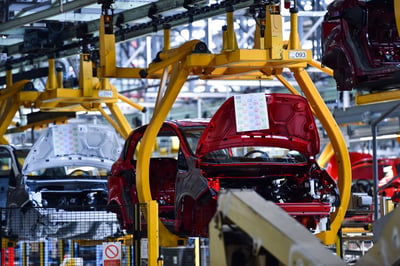 In automotive manufacturing, there are several things you can take for granted; unfortunately, some are unwelcome. The Six Big Losses are an uninvited guest in automotive manufacturing plants everywhere. They are the wastes that rob your organization of productivity, opportunity, time, and money, often under the radar.
In automotive manufacturing, there are several things you can take for granted; unfortunately, some are unwelcome. The Six Big Losses are an uninvited guest in automotive manufacturing plants everywhere. They are the wastes that rob your organization of productivity, opportunity, time, and money, often under the radar.
To counter the Six Big Losses, you have to understand them. Knowing what to look for is crucial when trying to eliminate waste in any form, especially concerning the Six Big Losses. Bringing them into the open early can help limit their ability to impact your process and allow you to reduce or rid yourself of them completely.
1. Breakdowns
Breakdowns result in downtime loss, often resulting from tooling failures, unplanned maintenance, general breakdowns, and equipment failure. Breakdowns usually happen without notice and can result in a lengthy and or expensive loss for the company. Machines are meant to be producing output, but when they are down, your organization loses the ability to achieve optimal performance. Simultaneously, process operators must sit and wait until their machine is up and running again.
Not all breakdowns can be avoided, but many can be anticipated when employees are encouraged to watch for potential problems and report issues right away. Improvement software for automotive manufacturing provides a receptacle for employee insights into potential breakdowns and other waste-producing problems.
2. Setup and Adjustments
Setup and adjustments also fall into the waste category of downtime, but they typically take less time than a breakdown. Examples of setup and adjustment are changeover, material shortage, operator shortage, and warm-up time.
Many auto manufacturing organizations have implemented setup time reduction improvements to reduce the impact of the set and adjustment loss. This is an area where incremental improvement can play an important role. Many PDSA cycles that lead to small improvements can substantially impact downtime related to setup and adjustments.

3. Small Stops
Small stops refer to anything that takes less than five minutes to get back to full operation and does not require maintenance personnel. Short stops fall under the speed loss category of waste. Examples are obstructed product flow, blocked sensors, component jams, misfeeds, delivery blocked, cleaning, or quick inspection.
The total impact of small stops can be tough to quantify due to the short amount of time it takes to fix them. However, to help eliminate them, process operators must be conscious of any small stop in production and record them in the improvement management system for review. Otherwise, they will continue to slow your process down.
4. Reduced Speed
When there is a difference in speed between actual operating speed and the equipment’s designed speed, you’re experiencing the waste of reduced speed. This gap is often assumed to be expected, but its impact can be significant over time.
The goal should always be to operate at maximum capacity. If there’s a gap, work towards eliminating it through the 5-whys root cause analysis. Any delta left unattended or underestimated is waste, and while it may seem insignificant at first, it can snowball into a big problem without notice.
5. Startup Rejects
Startup rejects are a quality waste. They happen during warm-up, startup, or the early production stages of the process. They may be the result of an improper setup or warm-up period. Startup rejects can lead to incorrect assembly, scrap, rework, and in-process damage.
![[Watch Now] How to Leverage Lean for Long-Term Success](https://no-cache.hubspot.com/cta/default/326641/eb5ac7b8-b040-48b7-810e-1589561ffff9.png)
6. Production Rejects
Production rejects are different from startup rejects because of when they occur and their root causes. The resulting loss is the same (lower quality), but production rejects happen during the steady-state production instead of the startup or a warm-up period. The more readily process operators can track rejects during a shift, the more information you will have to target root causes and possibly discover patterns that will help eliminate them entirely.
Getting complete control over the Six Big Losses in automotive manufacturing requires a culture that prides itself on continuous improvement with a path to perfection. It calls for awareness and the ability to seek out a loss when it presents itself. Your employees on the front lines need to be empowered to acknowledge the smallest losses and turn them into an opportunity for improvement.
The road to perfection is bumpy, but it’s not impossible.


Add a Comment